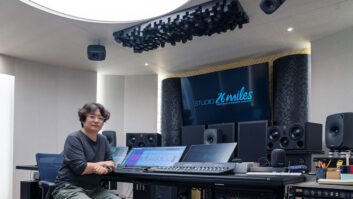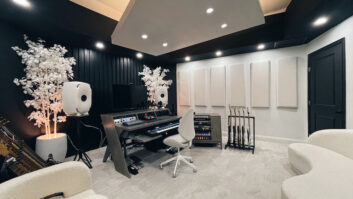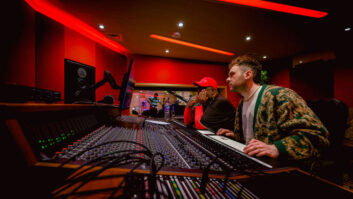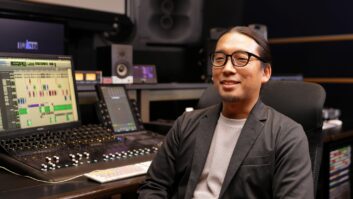
Rob Kahn, the creative director and founder of New York City’s Mixology Post
It’s impossible not to notice the upsurge in online video consumption. With YouTube claiming nearly 90 percent of unique views, according to Nielsen Online, the time that Americans are spending on video sites has escalated by more than 300 percent since 2003. But what does this mean for audio professionals? Is it good news? Bad news? Does it really matter at all? For the studio owners we talked to this month, the Internet has definitely had an impact, and it’s gone well beyond providing a simpler and more efficient delivery method to clients. Not only has it opened the door to new opportunities and sparked innovative approaches to optimizing sound quality, in some ways the Internet has triggered a complete overhaul in the way these studio owners do business.
No More Business as Usual?
“One of the greatest ways the Internet has affected us is that clients don’t come to the studio anymore,” says Rob Kahn, the creative director and founder of New York City’s Mixology Post, whose client roster includes A&E, ESPN, Showtime, the NHL and BMW. “The talent comes in, the engineer gets a phone patch set up, the producer produces over the phone from wherever he or she is, and then we post files via FTP. It’s a lot quieter around here these days.”
It’s even quieter in CJ DeVillar’s Santa Monica, Calif., studio. Roughly 95 percent of his clients communicate solely via e-mail, and he never meets them face-to-face. “I have a toll-free number, but hardly anyone ever uses it,” says DeVillar, owner of SongWorx and a longtime engineer who has worked on projects for such artists as Michael Jackson, O.A.R. and Disturbed. Not only has the Internet proved effective for communicating, but also for marketing. In fact, about half of the work he lands is a result of Google hits; the other half comes from Twitter and Facebook. He has found this type of networking much more effective than traditional advertising because it allows potential clients to get to know him on a more personal level, and he believes this is crucial. “Just about all of my clients prefer to communicate by text or e-mails, so the Internet has been extremely beneficial for me.”
Clients are even relying on Internet communication to evaluate and approve final mixes of projects. According to Kahn, clients lean toward this delivery method not because they can hear a mix especially well in their own offices, but because they can have access to it in a matter of minutes. “Believe it or not, a lot of times, even if we are working on a mix in surround sound, clients will ask us to post a file to the Internet for them to listen to and approve,” admits Kahn, who says that one of Mixology’s current clients, which happens to be a major cable TV network, recently made that very request.
And, of course, this system has provided studio owners expanded opportunities to work with clients who would have been impossible to reach in the past because of geographical or time restrictions. For example, of the nine of projects DeVillar is currently working on, only one is located on the West Coast. The remaining eight are scattered throughout the world in places like the Ukraine, UK, Japan, Poland and Montreal.
Kahn confesses that there are additional positives to this scenario. “Not having clients in the studio is great in that it has enhanced creativity since I don’t have to worry about them looking over my shoulder, which usually causes me to go to my tried-and-true methods to work more efficiently. But when I’m given the freedom to take an extra 15 minutes to try something fun and innovative, the client benefits because I’m able to produce something that’s more creative,” says Kahn. On the flipside, he does miss the collaborative nature that in-person studio sessions offer. “I do miss working with people,” he says, “and I miss all the fruit we used to have around the studio for clients.”
Haggar Audio’s Rob Haggar
More Changes
In addition to the Internet’s impact on the “how” of an audio professional’s work, it has also greatly impacted the “what.” Of the 70 percent of sound for picture work that Haggar Audio (Madison, Wisc.) does, roughly 60 percent ends up on the Internet, and a substantial chunk of the studio’s projects are being done strictly for the Internet. One such Internet-driven project was a series of “teaser” ads for Web-based GoDaddy.com, which aired during the Superbowl and directed viewers back to the GoDaddy site for the “reveal.” Haggar is also working on voice, music design and sound effects for three separate Websites that were created for the Wisconsin Milk Marketing Board to promote the use of dairy, along with several Internet videos for an American Family Insurance that were “heavy on the sound design.” “Most of the clients we deal with are hip to what the Internet can do for them,” says studio owner/sound designer Rob Haggar. “In fact, a lot of times it’s their first priority.” That was the case for Pennsylvania-based PPL Electric Utilities. To help complete a series of Webisodes, the company called on Mixology for significant sound design and mix work.
Companies are also seeking sound design services for less-traditional projects. Just consider a project DeVillar worked on for DeepRockDrive, a “revolutionary new music experience” that combines live performances with Internet capabilities, enabling fans and artists to interact with one another in a unique fashion. The project involved mixing music being performed live by artists on a soundstage to seven camera, HD video and then simultaneously Webcasting the performance. “What made the project especially interesting was not that the bands were performing live and I was having to mix on-the-fly, but that the artists were playing to 40 large-screen TVs that displayed feeds of fans watching, and they were able to interact with one another,” says DeVillar. Fans could also create their own versions of the show; they were given the ability to manipulate camera angles and provide feedback directly to the artists while they were onstage. The project required a team of expert software developers to put together and was viewed by as many as 10,000 viewers at one time.
Haggar is also working on voice, music design and sound effects for three separate Websites that were created for the Wisconsin Milk Marketing Board to promote the use of dairy.
The Case for Quality
It goes without saying that this new medium is the “next best thing” and will continue to rack up impressive statistics. The big issue from a sound perspective is, however, that sound quality on the Internet isn’t yet regulated like it is in broadcast and it tends to be all over the map quality-wise. So does that mean engineers should “dumb down” their mixes for projects that are being produced specifically for the Internet? That would be a resounding, “No way!”
“People may tolerate and expect a bad picture when bandwidth gets pinched, but they don’t tolerate bad sound very well,” says DeVillar. And bad sound is bad sound, whether it’s on the Internet or on TV. Take, for instance, a series of spots Mixology mixed for Bloomberg Sports. To meet a tight deadline, the very first of the spots was posted minus a professional mix. Instead, the production company producing the spots posted the initial one on the Web directly from the Avid. During a meeting, Kahn and one of the spot’s producers played that one and then compared it to one that Kahn had mixed. “To be honest, we were both shocked at the difference in quality,” says Kahn. “The truth is, it’s actually more important to mix projects that are airing on the Internet than for those on television because everything broadcast on the networks will go through some type of broadcast limiter, and there will be some control placed on loudness and dynamic range. But that’s not the case with the Internet.” It’s for that reason that Kahn tends to lighten up on the low end and mix brighter and with a lower dynamic range when he is working on a project for the Web. “With TV, you can get away with a decent amount of dynamic range, depending on content and context, but on the Web, certain audio elements can get lost a lot easier.”
DeVillar takes a slightly different approach, but also compensates for projects that he knows will be posted on YouTube. For starters, he makes sure that levels are optimized. “With the low bit rates that are present on YouTube, I’m careful to stay within mastering standards,” says DeVillar. Similar to Kahn, he makes sure that the mix doesn’t have a lot of unnecessary high end to prevent aliasing from the codecs.
Even if the initial plan for a project doesn’t involve the Internet, according to Haggar, it’s a good idea to assume that it will end up there. “It’s a safe bet that most of the projects we work on will wind up being posted on YouTube or somewhere else on the Internet, so I keep that in mind when I’m mixing,” says Haggar.”
But the biggest problem remains educating clients about the value of quality audio for Internet productions. There is still a perception that these types of projects are synonymous with lower budgets, but that’s simply not the case. “A project being produced for the Internet still has to be shot, edited, scored, mixed, et cetera, “ says Kahn. “It’s not like the process takes half the time, so why would it cost 50-percent less than a traditional project?”
While the mentality is beginning to change as more money is being spent on Internet advertising and more consumers are being exposed to these ads, there are already some companies that recognize that “good enough” just doesn’t cut it. “We spent multiple hours mixing the tutorials for PPL simply because they wanted a really great product,” says Kahn. “They could have cut the sound in the Avid, and they may have been able to get away with it, but they realized that it would all reflect on their brand, and if your brand sounds like garbage, your brand looks like garbage.”
CJ DeVillar of SongWorx
The Case for Quality
It goes without saying that this new medium is the “next best thing” and will continue to rack up impressive statistics. The big issue from a sound perspective is, however, that sound quality on the Internet isn’t yet regulated like it is in broadcast and it tends to be all over the map quality-wise. So does that mean engineers should “dumb down” their mixes for projects that are being produced specifically for the Internet? That would be a resounding, “No way!”
“People may tolerate and expect a bad picture when bandwidth gets pinched, but they don’t tolerate bad sound very well,” says DeVillar. And bad sound is bad sound, whether it’s on the Internet or on TV. Take, for instance, a series of spots Mixology mixed for Bloomberg Sports. To meet a tight deadline, the very first of the spots was posted minus a professional mix. Instead, the production company producing the spots posted the initial one on the Web directly from the Avid. During a meeting, Kahn and one of the spot’s producers played that one and then compared it to one that Kahn had mixed. “To be honest, we were both shocked at the difference in quality,” says Kahn. “The truth is, it’s actually more important to mix projects that are airing on the Internet than for those on television because everything broadcast on the networks will go through some type of broadcast limiter, and there will be some control placed on loudness and dynamic range. But that’s not the case with the Internet.” It’s for that reason that Kahn tends to lighten up on the low end and mix brighter and with a lower dynamic range when he is working on a project for the Web. “With TV, you can get away with a decent amount of dynamic range, depending on content and context, but on the Web, certain audio elements can get lost a lot easier.”
A recent project at SongWorx
DeVillar takes a slightly different approach, but also compensates for projects that he knows will be posted on YouTube. For starters, he makes sure that levels are optimized. “With the low bit rates that are present on YouTube, I’m careful to stay within mastering standards,” says DeVillar. Similar to Kahn, he makes sure that the mix doesn’t have a lot of unnecessary high end to prevent aliasing from the codecs.
Even if the initial plan for a project doesn’t involve the Internet, according to Haggar, it’s a good idea to assume that it will end up there. “It’s a safe bet that most of the projects we work on will wind up being posted on YouTube or somewhere else on the Internet, so I keep that in mind when I’m mixing,” says Haggar.”
But the biggest problem remains educating clients about the value of quality audio for Internet productions. There is still a perception that these types of projects are synonymous with lower budgets, but that’s simply not the case. “A project being produced for the Internet still has to be shot, edited, scored, mixed, et cetera, “ says Kahn. “It’s not like the process takes half the time, so why would it cost 50-percent less than a traditional project?”
While the mentality is beginning to change as more money is being spent on Internet advertising and more consumers are being exposed to these ads, there are already some companies that recognize that “good enough” just doesn’t cut it. “We spent multiple hours mixing the tutorials for PPL simply because they wanted a really great product,” says Kahn. “They could have cut the sound in the Avid, and they may have been able to get away with it, but they realized that it would all reflect on their brand, and if your brand sounds like garbage, your brand looks like garbage.”
Kevin Hill is the owner/engineer and Lisa Horan is the creative director of Studio Unknown, a full-service audio post-production facility and recording studio that specializes in helping clients discover creative sound for film, video, Web, gaming and artist projects.







